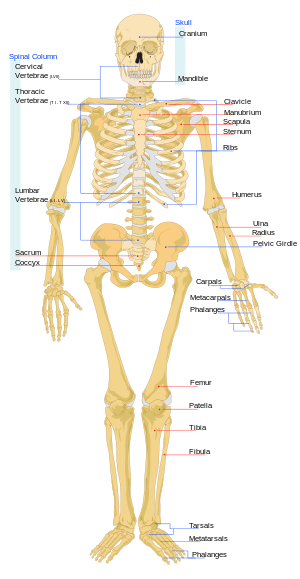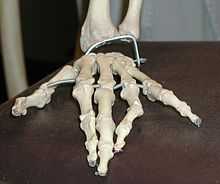Skeletal System

Skeletal System - a body system made up of bones, joints and connective tissues.
Marrow - a soft tissue in the center of some bones.
- Connecting Parts
Cartilage - A strong, flexible, gel like tissue that cushions your joint.
Tendons - Connect Muscles to bones.
Ligaments - Connect Bones to Bones.
Your skeletal system allows you to move.
There are 206 bones in the human body. A newborn has 350 bones.
What the Skeletal System helps?
- Supports the body by providing a framework for the body.
- Protects the internal organs. Example: Rib cage protects your heart and lungs.
- Stores Minerals. Example: Calcium and phosphorus.
- Makes blood cells in the bone Marrow.
Common Name for each Bone

- Tibia = Shin Bone
- Clavicle = Collarbone
- Vertebrae = Spine/Backbone
- Femur = Thigh
- Mandible = Jaw
- Scapula = Shoulder Bone
- Humerus = Arm
- Patella = Kneecap
- Pelvis = Hip
- Cranium = Skull
- Phalanges = Fingers and Toes
Joints
Joints is the point where to bones meet. Your fingers are a great example of joints, the so "cracking knuckles" is pulling away your joints.
Immobile, Slightly Immobile, and Mobile Joints
Immobile
- Immobile joints are joints that can't move.
Examples are the Skull and Cranium.
Slightly Immobile
- Slightly Immobile joints are joints that permit slight movement.
Examples: Between the vertebrae of the back.
Mobile
- Mobile joints are joints that permit wide movement joints.
Examples: Fingers
Connective Tissues
Tendons - connect muscles to bones.
Ligament - connect bones to bones.
Sprains/Diseases in relation with the Skeletal System
Fractures - A break in a bone caused by an injury.
Dislocations - When a bone is pushed out of its joint.
Sprain - Stretching or twisting of ligaments. (Full definition: Ligaments are short parts of tough, flexible connective tissues that connects two bones, or cartilages, or holds together a joint)
Overuse - Injuries - occurs over time.
Scoliosis - A disorder where the spine curves in a "C" or "S" like curve/shape.
Osteoporosis - A disease where the bones are brittle.
Taking care of your skeletal system
A. Good Diary products contain calcium, phosphorus, magnesium, and Vitamin D. These vitamins help with the strenghtening of bones.
B. Regular Exercise: Increases Bone Mass.
C. Good Posture helps keep the spine healthy/in balance.
D. Take time to heal: Wait for it to be completely heal before returning back into physical activity.
E. Use protective gear when doing physical activities, such as riding your bicycle.
Sources
- Notes